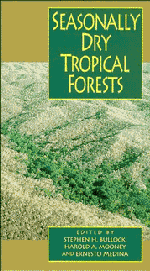Book contents
- Frontmatter
- Contents
- List of contributors
- Acknowledgements
- 1 Introduction
- 2 Dry forests of Central America and the Caribbean
- 3 Overview of the Brazilian caatinga
- 4 Savannas, woodlands and dry forests in Africa
- 5 Dry forest ecosystems of Thailand
- 6 The Cenozoic record of tropical dry forest in northern Latin America and the southern United States
- 7 Diversity and floristic composition of neotropical dry forests
- 8 Vertebrate diversity, ecology and conservation in neotropical dry forests
- 9 Diversity of life forms of higher plants in neotropical dry forests
- 10 Drought responses of neotropical dry forest trees
- 11 Plant reproduction in neotropical dry forests
- 12 Plant–herbivore interactions in Mesoamerican tropical dry forests
- 13 Biomass distribution and primary productivity of tropical dry forests
- 14 Nutrient cycling in tropical deciduous forests
- 15 Biology of the belowground system of tropical dry forests
- 16 Nitrogen trace gas emissions in a tropical dry forest ecosystem
- 17 Conversion of tropical dry forest to pasture and agriculture
- 18 Ethnobotany of the Mexican tropical dry forests
- Index
8 - Vertebrate diversity, ecology and conservation in neotropical dry forests
Published online by Cambridge University Press: 07 September 2010
- Frontmatter
- Contents
- List of contributors
- Acknowledgements
- 1 Introduction
- 2 Dry forests of Central America and the Caribbean
- 3 Overview of the Brazilian caatinga
- 4 Savannas, woodlands and dry forests in Africa
- 5 Dry forest ecosystems of Thailand
- 6 The Cenozoic record of tropical dry forest in northern Latin America and the southern United States
- 7 Diversity and floristic composition of neotropical dry forests
- 8 Vertebrate diversity, ecology and conservation in neotropical dry forests
- 9 Diversity of life forms of higher plants in neotropical dry forests
- 10 Drought responses of neotropical dry forest trees
- 11 Plant reproduction in neotropical dry forests
- 12 Plant–herbivore interactions in Mesoamerican tropical dry forests
- 13 Biomass distribution and primary productivity of tropical dry forests
- 14 Nutrient cycling in tropical deciduous forests
- 15 Biology of the belowground system of tropical dry forests
- 16 Nitrogen trace gas emissions in a tropical dry forest ecosystem
- 17 Conversion of tropical dry forest to pasture and agriculture
- 18 Ethnobotany of the Mexican tropical dry forests
- Index
Summary
Introduction
The neotropics may sustain the largest number of living species of plants and animals on earth (Wilson, 1988; McNeely et al., 1990). In the vast neotropical region, however, there are extensive regions such as the Amazonian rain forests, the Venezuelan ‘tepuis’, and the dry forests, where there is little biological knowledge of ecosystem composition and ecological interactions.
Research in neotropical dry forests during the last two decades has provided the scientific community with surprises such as the discovery of an ‘extinct’ peccary, Catagonus wagneri, in the Paraguayan chaco in 1974 (Wetzel et al., 1975). It is, therefore, important to recognize patterns of biological diversity in dry forest to gain insights into causal processes in biogeography and ecosystem function, and to assign them appropriate conservation values.
In this chapter I describe the general patterns of terrestrial vertebrate diversity and conservation in dry forests, and contrast them with patterns in adjacent moist/wet forests. The chapter is divided into five sections. In the first section, a general description of the major neotropical dry forests is given, emphasizing size and degree of perturbation. The following section presents a detailed analysis of patterns of species richness and diversity. The third section is dedicated to a description of community structure and ecological responses to climate seasonality. In the fourth section the origins of the dry forest vertebrate faunas are discussed. Finally, the last section is devoted to conservation problems.
- Type
- Chapter
- Information
- Seasonally Dry Tropical Forests , pp. 195 - 220Publisher: Cambridge University PressPrint publication year: 1995
- 30
- Cited by



